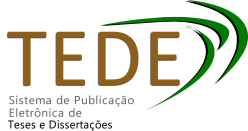| Compartilhamento |


|
Use este identificador para citar ou linkar para este item:
https://tedebc.ufma.br/jspui/handle/tede/6526| Tipo do documento: | Dissertação |
| Título: | Metáforas do amor na fala de mulheres vítimas diretas de violência doméstica |
| Título(s) alternativo(s): | Metaphors of love in the speech of women who are direct victims of domestic violence |
| Autor: | ALMEIDA, Hanna Gabrielle do Vale  |
| Primeiro orientador: | CARNEIRO, Monica Fontenelle |
| Primeiro coorientador: | CHAI, Cássius Guimarães |
| Primeiro membro da banca: | CARNEIRO, Monica Fontenelle |
| Segundo membro da banca: | CHAI, Cássius Guimarães |
| Terceiro membro da banca: | RODRIGUES, Tiago de Aguiar |
| Quarto membro da banca: | MUGSCHL, Sonia Maria Correa Pereira |
| Resumo: | Nesta dissertação propomo-nos a analisar as metáforas do amor na fala de mulheres vítimas diretas de violência doméstica, a partir dos discursos coletados em registros do Grupo Focal no material colhido da tese de Carneiro (2014) e na entrevista publicada na tese de Damacena (2021). O trabalho insere-se no âmbito da Linguística Cognitiva e utiliza conceitos dispostos na Teoria da Metáfora Conceptual Estendida, para demonstrar, com maior clareza, os conteúdos da cognição envolvidos/ativados no contexto em que se insere o discurso. Convém esclarecer que, atualmente, podemos dedicar à violência doméstica um olhar heterogêneo e multifacetado, segundo o qual, estatisticamente, a maior prejudicada é a mulher. Buscamos responder às seguintes questões de pesquisa: (1) Como as mulheres vítimas diretas de violência doméstica conceptualizam seus sentimentos e ideias sobre o amor? (2) Qual o papel do contexto na produção das metáforas? (3) Como as metáforas do amor, transgredidas por um contexto de violência, nos mostram detalhes da conceptualização de um sentimento universal? Para responder a essas questões, esta dissertação tem como objetivo geral analisar como são criados e compreendidos os conceitos do amor a partir de mecanismos metafóricos no contexto da violência doméstica. Como objetivos específicos temos: (i) identificar as metáforas do amor na fala das vítimas; (ii) analisar, através da abordagem multinível, a especificidade da metáfora no discurso das vítimas e (iii) mostrar o papel do contexto da violência doméstica na criação de metáforas do amor. A pesquisa é qualitativa de caráter descritivo-exploratório e nos permitiu não apenas investigar o fenômeno metafórico com mais especificidade, mas também entender que o mapeamento específico dos dados não parte de variáveis simples, mas de contextos cotidianos vivenciados que refletem a maneira como a vítima percebe, concebe, julga, conceitua e qualifica os acontecimentos vivenciados. Nessa abordagem, ancoramo-nos nos estudos de Lakoff e Johnson (1980), Lakoff (1987), Kövecses (2000, 2005, 2020), dentre outros. No que concerne às etapas da investigação, a análise está dividida em três momentos: (i) investigação qualitativa das categorias adotadas na investigação (domínios, frames, esquemas imagéticos e aspectos das emoções) no discurso das vítimas; (ii) aprofundamento dos sentidos produzidos a partir dessa organização e das categorias cognitivas ativadas também a partir dela, criando quadros de análises para os conceitos tradicionalmente dispostos, de acordo com a abordagem lexical e com o protótipo de amor; e (iii) identificação das metáforas de amor subjacentes às expressões e do papel do contexto de violência doméstica conjugal na criação dessas, e, ainda nesse sentido, identificamos os aspectos de emoção, mostrando que o contexto tem papel importante na criação de metáforas e que estas, transgredidas pelo contexto de violência doméstica, constituem a especificidade do modelo cognitivo de amor das vítimas. Em relação ao corpus, com os dados obtidos ao final dos procedimentos metodológicos, com base na abordagem multinível proposta por Kövecses (2020), foi possível desenvolver o trabalho de análise qualitativa da fala das vítimas no tocante às metáforas identificadas. Os dados revelaram que os aspectos do Amor, como Controle, Dano e Troca/Investimento, mostraram-se relevantes nas metáforas identificadas, contribuindo para o entendimento de como as dinâmicas de poder e codependência emocional e/ou financeira se manifestam nesses relacionamentos. Constatamos, assim, que tanto em situações de união quanto em relacionamentos abusivos, as vítimas podem ter uma percepção distorcida do que é amor, muitas vezes confundindo possessividade e controle com cuidado e afeto. Tal compreensão pode favorecer o desenvolvimento de outras investigações com foco na análise qualitativa das metáforas que se manifestam na fala de vítimas diretas de violência doméstica acerca de suas ideias e emoções em relação à agressão sofrida, quanto fomentar a conscientização sobre o problema da violência doméstica contra a mulher com o aprofundamento de estudos sobre as sequelas pertinentes à interação social das vítimas e suas idealizações sobre o sentimento. |
| Abstract: | In this dissertation, we propose to analyze the metaphors of love in the speech of women who are direct victims of domestic violence, based on the discourses collected in Focus Group recordings, the material gathered from Carneiro's thesis (2014), and the interview published in Damacena's thesis (2021). The work falls within the scope of Cognitive Linguistics and uses concepts from the Extended Conceptual Metaphor Theory to demonstrate, more clearly, the cognitive contents involved/activated in the context of the discourse. It is important to clarify that, currently, we can apply a heterogeneous and multifaceted perspective to domestic violence, according to which, statistically, the most affected are women. We seek to answer the following research questions: (1) How do women who are direct victims of domestic violence conceptualize their feelings and ideas about love? (2) What is the role of context in the production of metaphors? (3) How do metaphors of love, transgressed by a context of violence, reveal details of the conceptualization of a universal feeling? To answer these questions, this dissertation aims to analyze how concepts of love are created and understood through metaphorical mechanisms in the context of domestic violence. Specific objectives include: (i) identifying metaphors of love in victims' speech; (ii) analyzing, through a multilevel approach, the specificity of metaphor in victims' discourse; and (iii) demonstrating the role of the context of domestic violence in the creation of metaphors of love. This qualitative, descriptive-exploratory research allowed us not only to investigate the metaphorical phenomenon more specifically but also to understand that the specific mapping of the data does not begin with simple variables, but rather with everyday contexts that reflect how victims perceive, conceive, judge, conceptualize, and qualify the events they experience. In this approach, we draw on the studies of Lakoff and Johnson (1980), Lakoff (1987), Kövecses (2000, 2005, 2020), among others. Regarding the research stages, the analysis is divided into three moments: (i) qualitative investigation of the categories adopted in the investigation (domains, frames, image schemas, and aspects of emotions) in the victims' discourse; (ii) deepening the meanings produced from this organization and the cognitive categories also activated from it, creating analytical frameworks for the concepts traditionally arranged, according to the lexical approach and the prototype of love; and (iii) identification of the metaphors of love underlying the expressions and the role of the context of domestic violence in their creation. In this sense, we also identify the aspects of emotion, demonstrating that context plays an important role in the creation of metaphors and that these, transgressed by the context of domestic violence, constitute the specificity of the victims' cognitive model of love. Regarding the corpus, using the data obtained at the end of the methodological procedures, based on the multilevel approach proposed by Kövecses (2020), it was possible to develop a qualitative analysis of the victims' statements regarding the identified metaphors. The data revealed that aspects of love, such as control, harm, and exchange/investment, were relevant in the identified metaphors, contributing to the understanding of how power dynamics and emotional and/or financial codependency manifest in these relationships. We thus found that in both unions and abusive relationships, victims may have a distorted perception of love, often confusing possessiveness and control with care and affection. This understanding can foster the development of further research focusing on the qualitative analysis of metaphors expressed in the accounts of direct victims of domestic violence regarding their ideas and emotions regarding the aggression they suffered. It can also raise awareness of the problem of domestic violence against women through in-depth studies on the consequences of victims' social interactions and their idealizations of feelings. |
| Palavras-chave: | violência doméstica contra a mulher; teoria da metáfora conceptual estendida; metáforas do amor. domestic violence against women; extended conceptual metaphor theory; metaphors of love |
| Área(s) do CNPq: | Análise Linguística |
| Idioma: | por |
| País: | Brasil |
| Instituição: | Universidade Federal do Maranhão |
| Sigla da instituição: | UFMA |
| Departamento: | DEPARTAMENTO DE LETRAS/CCH |
| Programa: | PROGRAMA DE PÓS-GRADUAÇÃO EM LETRAS - Campus Bacanga |
| Citação: | ALMEIDA, Hanna Gabrielle do Vale. Metáforas do amor na fala de mulheres vítimas diretas de violência doméstica. 2025. 139 f. Dissertação (Programa de Pós-Graduação em Letras - Campus Bacanga) - Universidade Federal do Maranhão, São Luís, 2025. |
| Tipo de acesso: | Acesso Aberto |
| URI: | https://tedebc.ufma.br/jspui/handle/tede/6526 |
| Data de defesa: | 10-Abr-2025 |
| Aparece nas coleções: | DISSERTAÇÃO DE MESTRADO - PROGRAMA DE PÓS-GRADUAÇÃO EM LETRAS - CAMPUS BACANGA |
Arquivos associados a este item:
| Arquivo | Descrição | Tamanho | Formato | |
|---|---|---|---|---|
| HANNA_ALMEIDA.pdf | Dissertação de Mestrado | 3,1 MB | Adobe PDF | Baixar/Abrir Pré-Visualizar |
Os itens no repositório estão protegidos por copyright, com todos os direitos reservados, salvo quando é indicado o contrário.




